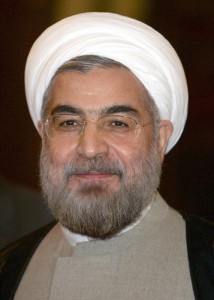The well-established tendency in Washington DC since the so-called “Khomeini Revolution” of 1979 to look for positive signs of change in the political ideology of the theocratic regime is hindering, not strengthening, the United States’ ability to devise a coherent strategy vis-à-vis Iran’s regional and global ambitions. Even worse, as Tehran is preparing to complete the presidential transition from the evil-clown, Mahmoud Ahmadinejad, to the smiling cleric, Hassan Rohani, who promised during his campaign to focus on the economy and improve Iran’s international standing, the United States and the rest of the world are getting a false sense of hope, relying on wishful thinking rather than preparing proper policies themselves.
Conversely, the basic challenge for the Iranian leadership will be in the coming months, and certainly in the coming years, the seemingly insoluble problem of maintaining the religious, or semi-religious, doctrine of Khomeini’s “guardianship of the jurist” as the main source of the regime’s legitimacy and implementing much needed political and economic reforms that, in turn, will require essential accommodations with the modern world and democracy. Indeed, the yawning chasm between the Westernized urban inhabitants and the religious rural population highlights the ever deepening religious, ideological and political divide inside the post-Khomeini Iran.
The brief and tightly managed presidential campaign and the subsequent election of a cleric and loyal bureaucrat, promoted as a moderate, also demonstrated the two faces of the theocratic regime. On the one hand, the ruling clergy relies on its self-proclaimed, silent majority that is deeply influenced by Islam. On the other hand, however, this self-confidence in the regime’s staying power is severely tested on a daily basis by a more activist and equally self-confident other half of the population that is unequivocally secular, pro-Western and hostile to the harsh authoritarianism of the Islamic republic. Thus, in spite of the impressive electoral triumph of Hassan Rohani, hailed as a seamless transfer of power, the religious, ideological and political differences have actually deepened under the incompetent, erratic and irrational presidency of his predecessor, Mahmoud Ahmadinejad.
It appears that Hassan Rohani possesses most of the attributes of a good natured, paternal dictator, who will implement a policy designed to appease the lower, middle and upper classes, while attempting to ease Iran’s isolation and the devastating economic effects of the international sanctions. Yet, two likely events might derail the regime’s planned transition to a benevolent autocracy. Internationally, both the developed and the developing countries will face new financial and economic challenges that will definitely affect their financial, economic, and in certain cases, political stability. Such a prospect, coupled with Iran’s moribund economy, will most likely render any attempt by the new president at progress and prosperity problematic. Domestically, because of the hybrid character of the Iranian constitution with its quasi-populist components, the new president appears to be the choice of the majority of the Iranian people. In reality, however, it was the Supreme Leader, Ali Khamenei and the non-elected institutions of the Islamic republic that placed Hassan Rohani at the head of the state and provided him with the powers necessary to govern and forge his elusive majority. As a result, the new president is not the product of the true national will but a part and a tool of the ruling autocracy.
For these reasons, as long as Khomeini’s farcical amalgamation of religious aberration, ideological deceit and political ambiguity remain the foundation of the Islamic republic, Iran will continue to hover between modernity and a lie that makes a mockery of its history, tradition, spirituality and culture. Possessing neither the legitimizing seal of truly free elections, nor the mandate of God, the Islamic republic, in its present structure, will be incapable of essentially changing its seditious character. Democratic legitimacy does not reside solely in triumphant elections and parliamentary majorities. The Iranian leaders must introduce real separation of powers and show genuine respect for their opponents in order to unite rather than divide the people. Theocracy is autocracy, which is a religious, ideological and political trap. Fused together in an intellectual disorder, such a state of affairs inevitably leads to rapid decline in the prestige of individuals as well as institutions.
Today’s Iran is like a rotten egg. On the outside, it masquerades as a republic with its semi-Western constitution and fully or partially elected officials and institutions. However, on the inside, the Islamic republic is being destroyed gradually by the Scylla of the autocracy, which protects its absolute powers with utmost brutality, and the Charybdis of its sins and faults, which condemns the regime to intellectual irrelevance and economic stagnation.
From its inception, the Islamic republic had been run by gerontocrats and epigones. The manner in which this so-called elite wasted eight long years under Mahmoud Ahmanidejad and the way it treated, and still treats, its young citizens, in particular women, illustrate a complete lack of vision and utter heartlessness. Governments, which live in the past, cannot shape the present and the future of their peoples. The Islamic Republic of Iran, in its current incarnation, is a religious, ideological and political anomaly. The future will show its fatal weaknesses and ultimate absurdity.
